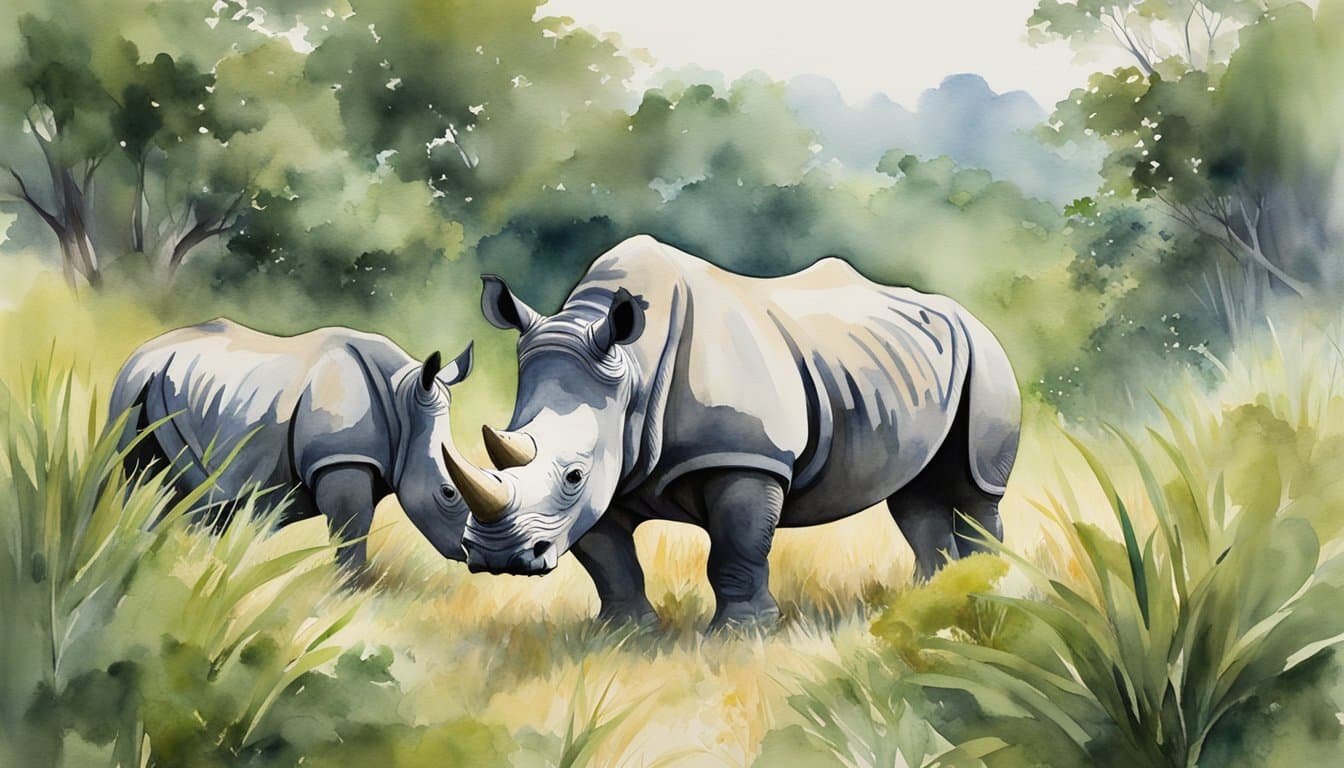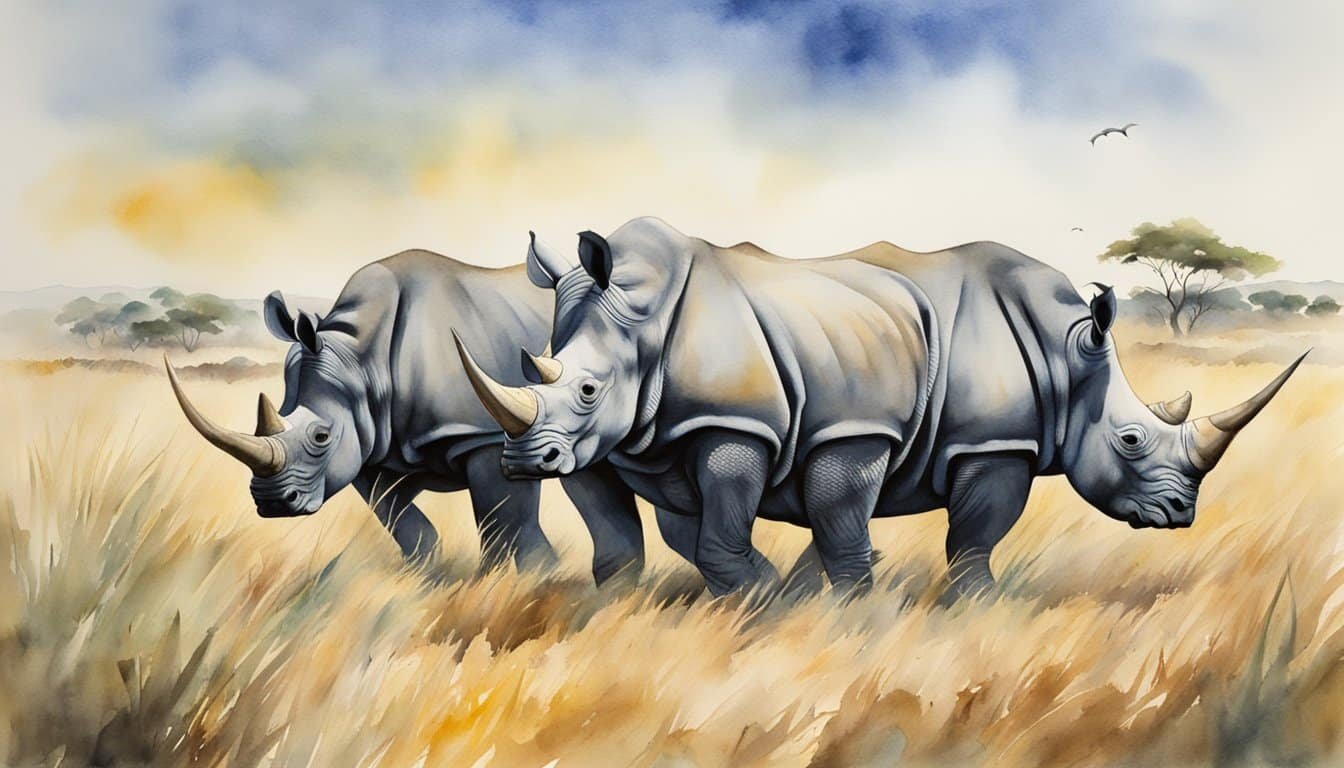Crisis of Rhino Poaching
The rhino poaching crisis has escalated to alarming levels, threatening the survival of these ancient animals. With shocking statistics and the peril of extinction, understanding the breadth and the triggers of this issue is crucial.
Scope and Scale of Poaching
In recent years, thousands of rhinos have fallen to poachers, driven by the high demand for rhino horn. For instance, it’s tragic that in South Africa alone, an epicenter for rhino biodiversity, poachers killed over 1,000 rhinos in both 2013 and 2014. Of the two African species, the white rhino now faces near-threat status, while the black rhino is critically endangered. The rhino population, once robust across the continent, has faced a dramatic decrease, with certain rhino subspecies already having met extinction.
Drivers Behind Poaching
The primary force behind the poaching epidemic is the lucrative black market for rhino horns, believed to possess medicinal properties in some cultures, although this is scientifically unproven. Driven by economic incentives, individuals and organized criminal syndicates have turned to poaching rhinos, seeing it as a high-profit activity. Furthermore, socio-economic factors such as poverty and unemployment in regions where rhinos live contribute to the complexities of combatting this crisis.
Global Impact and Conservation Efforts

The illegal poaching of rhinoceroses has far-reaching consequences, threatening not only the species but also the ecological balance. Conservation efforts spread across various continents with global collaboration to ensure these magnificent animals continue to grace our natural world.
Conservation Strategies
In the fight to protect rhinoceroses, African countries like South Africa, Kenya, Zimbabwe, and Namibia innovate with diverse conservation strategies. For instance, the practice of de-horning, aiming to deter poachers, involves safely removing a rhino’s horn to make it less of a target. Organizations like the Lowveld Rhino Trust in Zimbabwe concentrate on safeguarding rhino populations through intensive protection and monitoring schemes. Counterintuitively, some private reserves in South Africa turn to legal, regulated trade within the country’s borders as a means to fund conservation efforts and de-incentivize illegal killing.
International Efforts Against Poaching
The illegal wildlife trade is truly global, with demand for rhino horn primarily emanating from markets in Asia, where it’s mistakenly believed to possess medicinal properties. Addressing this issue has called for international initiatives like Operation: Stop Poaching Now, aiming at boosting law enforcement and anti-poaching activities. Additionally, renowned wildlife parks such as Kruger National Park in South Africa employ advanced technology and rangers rigorously trained in counter-poaching techniques. These dedicated conservationists work tirelessly, often risking their lives to curb a wave of wildlife crime that threatens not just the rhinos but regional stability and economic development derived from tourism.
Demand for Rhino Horn: Myths and Markets

Demand for rhino horns is fueled by a mix of cultural myths and clandestine transactions. Rhino horn, often surrounded by misconceptions regarding its medicinal value, has been a cornerstone in the illegal wildlife trade.
Cultural Significance and Myths
In parts of Asia, notably Vietnam, rhino horn is steeped in tradition and symbolic meaning. It is erroneously believed to possess aphrodisiac properties and medicinal value, with claims that it can cure fever, rheumatism, gout, and other ailments. This belief is grounded in centuries-old traditional Chinese medicine practices, although scientifically, rhino horn is primarily composed of keratin, the same substance in human hair and fingernails, and has no proven health benefits.
Black Market Dynamics
The black market for rhino horn operates in the shadows, beyond the reach of law and governance. Despite the ban on international trade, rhino horns are trafficked across borders, commanding high prices. They are a status symbol for some, showcasing wealth and prestige. The demand for the horn continues unabated, influencing poaching activities and putting the survival of rhinos at severe risk. Systems like ‘Tam,’ a centuries-old Asian barter trade practice, further facilitate this covert industry, underscoring the complexity of curbing the trade.

